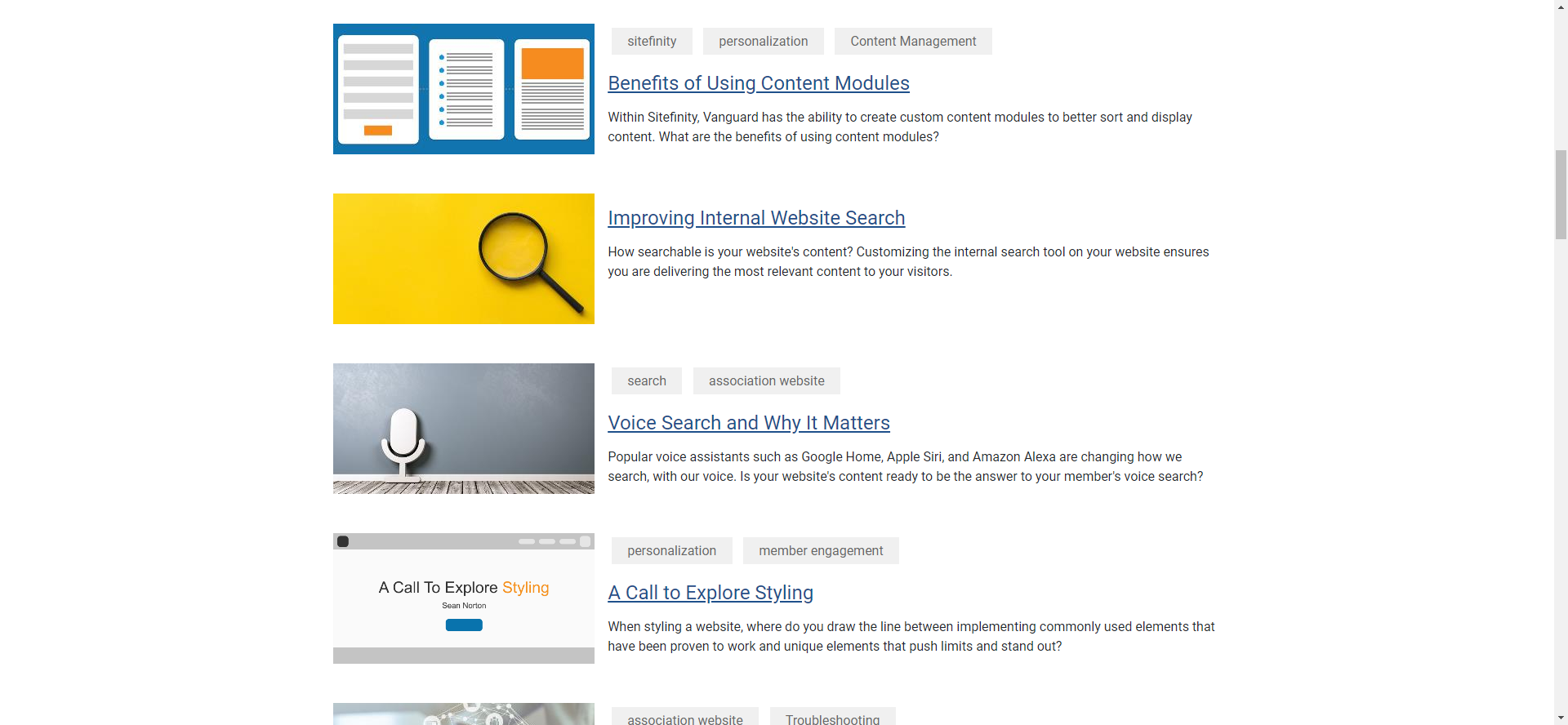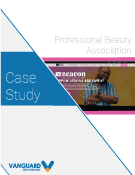Web Smarts - Business Savvy
We’ve been building websites since 1998
We are trusted advisors to Over 50 Active Clients within several industries including associations and nonprofits, healthcare, financial services, retail, B2B and more.

We Are
Trusted
Partners
After we deliver a quality website on time and within your budget, we will be there for when it really counts. We will be proactive, consultative and strategic after we launch your website.

We Are
Integration
Experts
We’ve integrated with virtually every AMS system on the market as well as most LMS, publication, advocacy and career center applications. Our company was founded on custom development.

We build websites that are easy to edit, manage and design using the best content management system on the market, Sitefinity CMS.
We Provide A Full Spectrum Of Services
Our Clients Are Our Partners....
John Wurm

The team at Vanguard helped us think about our digital presence from the perspective and needs of our users, while holding true to the values our organization espouses.
Connect With Us
Improve Your Webcopy

The
Vanguard View
Technology articles about one topic from the perspective of Leadership, Marketing and IT professionals .
A Blog Article About Blog Writing
Aside from your website’s content, many organizations choose to publish and maintain their own blog. Blogs are a form of content marketing, which allow your organization to reach a wider range of your target audience. You might regularly follow or manage blogs, or you might not know the first thing about them. That’s totally fine! This article will give you helpful tips and guidelines to follow when creating or writing a blog for your organization.
What is a blog?
Blogging may seem like a fairly new term, but it was actually invented in the 1990’s and referred to as an ‘online diary.’ Keep in mind, at this time the Web was a fairly new concept to the average person. One of the first blogging platforms was called Open Diary, and it was set up like a forum, allowing other ‘diarists’ to read and comment on each other’s entries. Online diaries were mainly used as a way for individuals to take personal notes or daily observations. This eventually became “web logging,” and eventually was shortened to “blog.” Many other blogging platforms such as Blogger, Xanga and LiveJournal began to emerge online.
Within the early 2000’s, people who once used blogs for personal use or hobbies discovered how to monetize it. This has only expanded since. In fact, some individuals have based their careers around blogging and vlogging (video logging) and earn millions of dollars each year doing so. The traction and publicity of blogging beguiled businesses, corporations and organizations to explore it as well.
According to a study from Daily Infographic, business owners see a 126 percent increase in lead generation if they blog about their industry. Naturally, blogging has become a significant part of many businesses’ content marketing strategies.
Blogging is constantly evolving, and there really isn’t a set standard for what a blog is supposed to look like. This gives bloggers and organizations creative freedom to customize as they please, essentially making up their own set of rules, which is what makes blogging so compelling.
Who are you writing for?
A blog can be a great place for you to share helpful tips or organization and industry news and updates. If you want to draw additional traffic to your site, creating a blog might just be your best option.
First and foremost, you will need to decide what audience you would like to reach. Are you writing for your members, or are you trying to reach a new audience? This is a question you must ask yourself before creating a blog to use as a part of your overarching content marketing strategy.
It is entirely possible to reach multiple audiences with your organization’s blog. In fact, it is encouraged, as long as each post is tailored to just one. Each time you write an article, you should have one specific audience in mind. You don’t have to appeal to every audience in every post. The key is to stay narrowed and specific.
Once you establish who you are writing for, it is time to decide why you are writing. What point do you want to get across?
What information might your audience (or potential audience) be looking for?
Once you determine who you are writing for, you need to consider what blog article topics will be relevant to your target audience. This requires a bit of research. Check out leading publications in your industry or look to social media to see what people are talking about. One of the easiest ways to get a gauge for what kind of content your audiences are looking for is to simply ask. Create a quick 5-minute survey to send to staff and members to see what they are interested in talking or learning more about.
Once you get a feel for what kind of content your audience is looking for, we recommend brainstorming topics. Make a large list of potential topics based on your own ideas and your research findings. Divide this list by your audience(s).
I know you are eager to start writing, but before you do, make sure to plan ahead. Create a content marketing calendar to map out what topics should be posted when. Keep holidays, timely news, and other events in mind when creating your content marketing calendar. You don’t want to spend precious time writing a well-thought-out post just to find out that there was an annual conference on the day it was scheduled to go live, resulting in minimal traffic.
Blog design
Aesthetic is everything. Think about the labels in the grocery store. You are more likely to pick up a can of soup with aesthetically pleasing packaging than you would a plain can that just says “Soup.” Same goes for your blog. People have a short intention span as it is, especially online. In fact, the average user’s intention span is about 8 seconds.This means, you need to grab your readers’ attention in that time frame.
The use of creative and compelling imagery is helpful, but more importantly, is the blog layout itself visually appealing and easy to navigate? If the reader has to jump through multiple hoops to get to the article, you may lose them.
Make sure the title is BIG and bold, but not too long. We recommend between 4 and 8 words. We see many organizations have success when they supply preview text for the article next to a thumbnail photo on the main blog page to entice the reader to click. The text should give a very brief overview of the article, and in some cases might pose a question to draw in readers. Vanguard follows those same rules when it comes to our blog (see screen capture below).

Another way to draw more traffic to your blog from your website is to have your web developer display a link in your home page navigation, or even create a ‘Featured Blog Article” section to display on your home page.
Setting the tone
Before writing, look through the content of your website. What is the tone of voice used in the text? If it consists of mainly professional language, you may want to tie some of it into your blog entries. With a blog, you do not have to be as formal and standardized in your language. You have the freedom to be a bit more conversational and opinionated.
To set the right tone, begin with organization. Create a rough outline to your thoughts. Starting with this organization in the drafting phase will help guide you to stay on track and on topic. To make writing (and reading) easier, break up text with bullet points, numbered lists, or headings (like this article). Try to keep the word count below 1,500 words. By giving yourself a word limit, you are less likely to stray away from your main points, keeping your topic and scope narrowed.
Blog management and reach
Many Content Management Systems, like Sitefinity, make managing your blog simple and painless. Sitefinity allows the blog’s authors and managers to easily create, publish and modify posts, and incorporate mages, videos and more with ease. You don’t have to worry about using HTML, but you have the option to if you choose. This makes blog management data-sf-ec-immutable="">
To increase viewer reach on your posts, we always recommend sharing each blog article across all necessary social media platforms including LinkedIn, Twitter and Facebook. Take that into consideration when writing. Think about posts you would share on your professional or personal social media pages. Does this article entice readers to share?
You blog can also serve a platform for conversation data-sf-ec-immutable="" starters regarding industry-focused topics, with you being the thought leader. By enabling the ‘comments’ section, users can comment directly on the post, and the comments will display directly below the article.
Lastly, it is important to measure your results. After you have published several articles, you should see your viewer count rise. You should be noticing a pattern of your engagement rising slowly. That is an indicator that your posts are resonating well. If you notice the viewer or engagement count is stagnant, try to determine if the posts could be more relevant. Ask yourself, what day/time sees the best engagement results? Is my blog easily accessible, or is it hidden somewhere within the website where nobody would look to go to? Do I need new content? Am I not posting enough, or am I posting too much? These are questions to ask as you review your data and results. Keep in mind, finding the sweet spot for blogging is essentially trial and error, and it varies from industry to industry. But once you work out the kinks, your Association will benefit from the results.
Happy Blogging!
Utilizing blogging can be extremely helpful to organizations. Not only will you be producing regular new content for your readers, but you will also learn a lot from your research and findings that may help your organization in ways you never predicted. You may find that your members look forward to your new post each week and find the content relevant and helpful to their lives. You might notice that you establish credibility and influence in your industry, and maybe even land additional members or business. The possibilities are endless.
What are you waiting for? Start blogging!
Vanguard Tips & Tricks
We provide helpful hints you never knew you needed for our clients. Check out "Vanguard Tips & Tricks" to learn quick and simple hacks to make managing your website easier than ever.
A Blog Article About Blog Writing
Aside from your website’s content, many organizations choose to publish and maintain their own blog. Blogs are a form of content marketing, which allow your organization to reach a wider range of your target audience. You might regularly follow or manage blogs, or you might not know the first thing about them. That’s totally fine! This article will give you helpful tips and guidelines to follow when creating or writing a blog for your organization.
What is a blog?
Blogging may seem like a fairly new term, but it was actually invented in the 1990’s and referred to as an ‘online diary.’ Keep in mind, at this time the Web was a fairly new concept to the average person. One of the first blogging platforms was called Open Diary, and it was set up like a forum, allowing other ‘diarists’ to read and comment on each other’s entries. Online diaries were mainly used as a way for individuals to take personal notes or daily observations. This eventually became “web logging,” and eventually was shortened to “blog.” Many other blogging platforms such as Blogger, Xanga and LiveJournal began to emerge online.
Within the early 2000’s, people who once used blogs for personal use or hobbies discovered how to monetize it. This has only expanded since. In fact, some individuals have based their careers around blogging and vlogging (video logging) and earn millions of dollars each year doing so. The traction and publicity of blogging beguiled businesses, corporations and organizations to explore it as well.
According to a study from Daily Infographic, business owners see a 126 percent increase in lead generation if they blog about their industry. Naturally, blogging has become a significant part of many businesses’ content marketing strategies.
Blogging is constantly evolving, and there really isn’t a set standard for what a blog is supposed to look like. This gives bloggers and organizations creative freedom to customize as they please, essentially making up their own set of rules, which is what makes blogging so compelling.
Who are you writing for?
A blog can be a great place for you to share helpful tips or organization and industry news and updates. If you want to draw additional traffic to your site, creating a blog might just be your best option.
First and foremost, you will need to decide what audience you would like to reach. Are you writing for your members, or are you trying to reach a new audience? This is a question you must ask yourself before creating a blog to use as a part of your overarching content marketing strategy.
It is entirely possible to reach multiple audiences with your organization’s blog. In fact, it is encouraged, as long as each post is tailored to just one. Each time you write an article, you should have one specific audience in mind. You don’t have to appeal to every audience in every post. The key is to stay narrowed and specific.
Once you establish who you are writing for, it is time to decide why you are writing. What point do you want to get across?
What information might your audience (or potential audience) be looking for?
Once you determine who you are writing for, you need to consider what blog article topics will be relevant to your target audience. This requires a bit of research. Check out leading publications in your industry or look to social media to see what people are talking about. One of the easiest ways to get a gauge for what kind of content your audiences are looking for is to simply ask. Create a quick 5-minute survey to send to staff and members to see what they are interested in talking or learning more about.
Once you get a feel for what kind of content your audience is looking for, we recommend brainstorming topics. Make a large list of potential topics based on your own ideas and your research findings. Divide this list by your audience(s).
I know you are eager to start writing, but before you do, make sure to plan ahead. Create a content marketing calendar to map out what topics should be posted when. Keep holidays, timely news, and other events in mind when creating your content marketing calendar. You don’t want to spend precious time writing a well-thought-out post just to find out that there was an annual conference on the day it was scheduled to go live, resulting in minimal traffic.
Blog design
Aesthetic is everything. Think about the labels in the grocery store. You are more likely to pick up a can of soup with aesthetically pleasing packaging than you would a plain can that just says “Soup.” Same goes for your blog. People have a short intention span as it is, especially online. In fact, the average user’s intention span is about 8 seconds.This means, you need to grab your readers’ attention in that time frame.
The use of creative and compelling imagery is helpful, but more importantly, is the blog layout itself visually appealing and easy to navigate? If the reader has to jump through multiple hoops to get to the article, you may lose them.
Make sure the title is BIG and bold, but not too long. We recommend between 4 and 8 words. We see many organizations have success when they supply preview text for the article next to a thumbnail photo on the main blog page to entice the reader to click. The text should give a very brief overview of the article, and in some cases might pose a question to draw in readers. Vanguard follows those same rules when it comes to our blog (see screen capture below).

Another way to draw more traffic to your blog from your website is to have your web developer display a link in your home page navigation, or even create a ‘Featured Blog Article” section to display on your home page.
Setting the tone
Before writing, look through the content of your website. What is the tone of voice used in the text? If it consists of mainly professional language, you may want to tie some of it into your blog entries. With a blog, you do not have to be as formal and standardized in your language. You have the freedom to be a bit more conversational and opinionated.
To set the right tone, begin with organization. Create a rough outline to your thoughts. Starting with this organization in the drafting phase will help guide you to stay on track and on topic. To make writing (and reading) easier, break up text with bullet points, numbered lists, or headings (like this article). Try to keep the word count below 1,500 words. By giving yourself a word limit, you are less likely to stray away from your main points, keeping your topic and scope narrowed.
Blog management and reach
Many Content Management Systems, like Sitefinity, make managing your blog simple and painless. Sitefinity allows the blog’s authors and managers to easily create, publish and modify posts, and incorporate mages, videos and more with ease. You don’t have to worry about using HTML, but you have the option to if you choose. This makes blog management data-sf-ec-immutable="">
To increase viewer reach on your posts, we always recommend sharing each blog article across all necessary social media platforms including LinkedIn, Twitter and Facebook. Take that into consideration when writing. Think about posts you would share on your professional or personal social media pages. Does this article entice readers to share?
You blog can also serve a platform for conversation data-sf-ec-immutable="" starters regarding industry-focused topics, with you being the thought leader. By enabling the ‘comments’ section, users can comment directly on the post, and the comments will display directly below the article.
Lastly, it is important to measure your results. After you have published several articles, you should see your viewer count rise. You should be noticing a pattern of your engagement rising slowly. That is an indicator that your posts are resonating well. If you notice the viewer or engagement count is stagnant, try to determine if the posts could be more relevant. Ask yourself, what day/time sees the best engagement results? Is my blog easily accessible, or is it hidden somewhere within the website where nobody would look to go to? Do I need new content? Am I not posting enough, or am I posting too much? These are questions to ask as you review your data and results. Keep in mind, finding the sweet spot for blogging is essentially trial and error, and it varies from industry to industry. But once you work out the kinks, your Association will benefit from the results.
Happy Blogging!
Utilizing blogging can be extremely helpful to organizations. Not only will you be producing regular new content for your readers, but you will also learn a lot from your research and findings that may help your organization in ways you never predicted. You may find that your members look forward to your new post each week and find the content relevant and helpful to their lives. You might notice that you establish credibility and influence in your industry, and maybe even land additional members or business. The possibilities are endless.
What are you waiting for? Start blogging!
Case Studies
Vanguard conducts thorough preliminary investigative work to ensure your website is built to cater specifically to your target audience and meet your organization’s goals. Check out some of the case studies on some of our most recent client success stories.
What Can Vanguard Do For You?
As your organization grows and evolves, your website should as well. Whether you are looking to generate more traffic, implement custom functionality, mobile compatibility, integrate your systems, or give your site a complete redesign, Vanguard Technology is your go-to web partner. Reach out to us with your current concerns with your website, and our experts will happily provide a solution.










Leave a commentOrder by
Newest on top Oldest on top